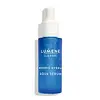What's inside
What's inside
 Key Ingredients
Key Ingredients

No key ingredients
 Benefits
Benefits

 Concerns
Concerns

 Ingredients Side-by-side
Ingredients Side-by-side

Water
Skin ConditioningCaprylic/Capric Triglyceride
MaskingTheobroma Cacao Seed Butter
EmollientJojoba Esters
EmollientCetearyl Alcohol
EmollientCetyl Esters
EmollientGlycerin
HumectantCera Alba
EmollientPolysorbate 60
EmulsifyingSorbitan Stearate
EmulsifyingEucalyptus Globulus Leaf Oil
PerfumingPrunus Amygdalus Dulcis Oil
Skin ConditioningPhenoxyethanol
PreservativePanthenol
Skin ConditioningBenzoic Acid
MaskingDehydroacetic Acid
PreservativeLimonene
PerfumingSodium Hydroxide
BufferingEthylhexylglycerin
Skin ConditioningCitric Acid
BufferingWater, Caprylic/Capric Triglyceride, Theobroma Cacao Seed Butter, Jojoba Esters, Cetearyl Alcohol, Cetyl Esters, Glycerin, Cera Alba, Polysorbate 60, Sorbitan Stearate, Eucalyptus Globulus Leaf Oil, Prunus Amygdalus Dulcis Oil, Phenoxyethanol, Panthenol, Benzoic Acid, Dehydroacetic Acid, Limonene, Sodium Hydroxide, Ethylhexylglycerin, Citric Acid
Water
Skin ConditioningButylene Glycol
HumectantPropanediol
SolventBetula Alba Juice
AstringentGlycerin
HumectantPhenoxyethanol
PreservativePEG-40 Hydrogenated Castor Oil
EmulsifyingSaccharide Isomerate
HumectantBetaine
HumectantXanthan Gum
EmulsifyingTrehalose
HumectantUrea
BufferingHydrolyzed Hyaluronic Acid
HumectantEthylhexylglycerin
Skin ConditioningSodium Hyaluronate
HumectantPentylene Glycol
Skin ConditioningDisodium EDTA
Caprylyl Glycol
EmollientSerine
MaskingMagnesium Aspartate
Skin ConditioningZinc Gluconate
Skin ConditioningSodium Hydroxide
BufferingPhenethyl Alcohol
MaskingCitric Acid
BufferingAlgin
MaskingDisodium Phosphate
BufferingGlyceryl Polyacrylate
Pullulan
Sodium Citrate
BufferingSodium Carrageenan
Emulsion StabilisingCopper Gluconate
Skin ConditioningGlucose
HumectantPotassium Phosphate
BufferingMaris Sal
Skin ConditioningChondrus Crispus Extract
Skin ConditioningLinalool
PerfumingParfum
MaskingWater, Butylene Glycol, Propanediol, Betula Alba Juice, Glycerin, Phenoxyethanol, PEG-40 Hydrogenated Castor Oil, Saccharide Isomerate, Betaine, Xanthan Gum, Trehalose, Urea, Hydrolyzed Hyaluronic Acid, Ethylhexylglycerin, Sodium Hyaluronate, Pentylene Glycol, Disodium EDTA, Caprylyl Glycol, Serine, Magnesium Aspartate, Zinc Gluconate, Sodium Hydroxide, Phenethyl Alcohol, Citric Acid, Algin, Disodium Phosphate, Glyceryl Polyacrylate, Pullulan, Sodium Citrate, Sodium Carrageenan, Copper Gluconate, Glucose, Potassium Phosphate, Maris Sal, Chondrus Crispus Extract, Linalool, Parfum
Ingredients Explained
These ingredients are found in both products.
Ingredients higher up in an ingredient list are typically present in a larger amount.
Citric Acid is an alpha hydroxy acid (AHA) naturally found in citrus fruits like oranges, lemons, and limes.
Like other AHAs, citric acid can exfoliate skin by breaking down the bonds that hold dead skin cells together. This helps reveal smoother and brighter skin underneath.
However, this exfoliating effect only happens at high concentrations (20%) which can be hard to find in cosmetic products.
Due to this, citric acid is usually included in small amounts as a pH adjuster. This helps keep products slightly more acidic and compatible with skin's natural pH.
In skincare formulas, citric acid can:
While it can provide some skin benefits, research shows lactic acid and glycolic acid are generally more effective and less irritating exfoliants.
Most citric acid used in skincare today is made by fermenting sugars (usually from molasses). This synthetic version is identical to the natural citrus form but easier to stabilize and use in formulations.
Read more about some other popular AHA's here:
Learn more about Citric AcidEthylhexylglycerin (we can't pronounce this either) is commonly used as a preservative and skin softener. It is derived from glyceryl.
You might see Ethylhexylglycerin often paired with other preservatives such as phenoxyethanol. Ethylhexylglycerin has been found to increase the effectiveness of these other preservatives.
Glycerin is already naturally found in your skin. It helps moisturize and protect your skin.
A study from 2016 found glycerin to be more effective as a humectant than AHAs and hyaluronic acid.
As a humectant, it helps the skin stay hydrated by pulling moisture to your skin. The low molecular weight of glycerin allows it to pull moisture into the deeper layers of your skin.
Hydrated skin improves your skin barrier; Your skin barrier helps protect against irritants and bacteria.
Glycerin has also been found to have antimicrobial and antiviral properties. Due to these properties, glycerin is often used in wound and burn treatments.
In cosmetics, glycerin is usually derived from plants such as soybean or palm. However, it can also be sourced from animals, such as tallow or animal fat.
This ingredient is organic, colorless, odorless, and non-toxic.
Glycerin is the name for this ingredient in American English. British English uses Glycerol/Glycerine.
Learn more about GlycerinPhenoxyethanol is a preservative that has germicide, antimicrobial, and aromatic properties. Studies show that phenoxyethanol can prevent microbial growth. By itself, it has a scent that is similar to that of a rose.
It's often used in formulations along with Caprylyl Glycol to preserve the shelf life of products.
Sodium Hydroxide is also known as lye or caustic soda. It is used to adjust the pH of products; many ingredients require a specific pH to be effective.
In small amounts, sodium hydroxide is considered safe to use. However, large amounts may cause chemical burns due to its high alkaline.
Your skin has a natural pH and acid mantle. This acid mantle helps prevent harmful bacteria from breaking through. The acid mantle also helps keep your skin hydrated.
"Alkaline" refers to a high pH level. A low pH level would be considered acidic.
Learn more about Sodium HydroxideWater. It's the most common cosmetic ingredient of all. You'll usually see it at the top of ingredient lists, meaning that it makes up the largest part of the product.
So why is it so popular? Water most often acts as a solvent - this means that it helps dissolve other ingredients into the formulation.
You'll also recognize water as that liquid we all need to stay alive. If you see this, drink a glass of water. Stay hydrated!
Learn more about Water